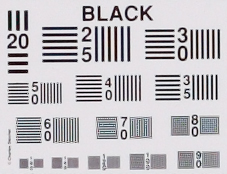EXCERPT page containing first few paragraphs. 2024-04-17 18:04:38
UA_SEARCH_BOT_null @ 3.145.52.86
For full access, subscribe here. Or click title to login. ![]()
Example—Resolution Chart
Let’s take a look at actual results on high contrast black and white. Note that real-world images often start with lower contrast; these black and white results are as good as can be expected. Remember too that diffraction varies with wavelength: the limits will be reached earlier for red light vs blue, both because of the sensor technology (Bayer array and demosaicing and discrete sampling) as well as diffraction vs wavelength.
For the examples below, the Nikon 85mm f/2.8D PC-Micro-Nikkor was used on both the 21MP Canon EOS 1Ds Mark III and the 12MP Nikon D3, at whole apertures from f/2.8 through f/45. In theory, because the Nikon D3 has photosites approximately 32% larger (linearly) than the Canon EOS 1Ds Mark III, it should be possible to stop down about 2/3 stop more before diffraction limits resolution. This is not borne out by this example however, at least using whole-stop increments. The two cameras are essentially equal in resolving power by f/32. The anti-aliasing filter could be a factor.
Article continues for subscribers...
Diglloyd Making Sharp Images is by yearly subscription. Subscribe now for about 13 cents a day ($50/year).
BEST DEAL: get full access to ALL 8 PUBLICATIONS for only about 75 cents a day!
Diglloyd Making Sharp Images articulates years of best practices and how-to, painstakingly learned over a decade of camera and lens evaluation.
Save yourself those years of trial and error by jump-starting your photographic technical execution when making the image. The best lens or camera is handicapped if the photographer fails to master perfect shot discipline. High-resolution digital cameras are unforgiving of errors, at least if one wants the best possible results.
- Eases into photographic challenges with an introductory section.
- Covers aspects of digital sensor technology that relate to getting the best image quality.
- Technique section discusses every aspect of making a sharp image handheld or on a tripod.
- Depth of field and how to bypass depth of field limitations via focus stacking.
- Optical aberrations: what they are, what they look like, and what to do about them.
- MTF, field curvature, focus shift: insight into the limitations of lab tests and why imaging performance is far more complex than it appears.
- Optical aberrations: what they are, what they look like, and what to do about them.
- How to test a lens for a “bad sample”.
Intrigued? See Focusing Zeiss DSLR Lenses For Peak Performance, PART ONE: The Challenges, or (one topic of many) field curvature.

Canon EOS 1Ds Mark III + Nikon 85mm f/2.8D PC-Micro-Nikkor.

